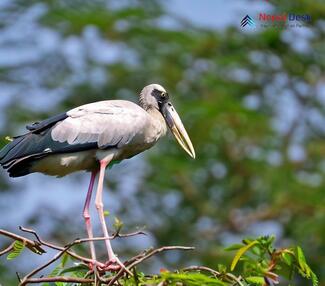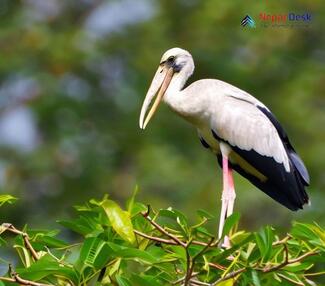Nepal is home to an incredibly diverse range of bird species, with more than 900 identified across the country's varied ecosystems. Among these, the Asian Openbill (Anastomus oscitans) stands out as a unique and fascinating creature. It is a large wading bird in the stork family Ciconiidae. The Asian openbill was first formally described in 1780. At a distance, they can appear somewhat like a white stork or Oriental stork. In this article, we'll delve into the world of the Asian Openbill, exploring its distinguishing characteristics, habitat preferences, and distribution in Nepal.
Distinguishing Features of the Asian Openbill
The Asian Openbill is a medium-sized stork with striking physical features that make it easily recognizable among other bird species. Its most distinguishing characteristic is its unusual bill shape from which it gets its name; the two halves of its bill do not fully close together, leaving an open gap between them. This adaptation is believed to help the bird efficiently catch and consume its primary food source, freshwater snails.
These storks have a predominantly grey plumage with glossy black wings and tails, standing at about 81 cm in height. Their legs are relatively short and long-necked, giving them their distinct posture when wading through shallow water in search of prey.
Habitat and Distribution in Nepal
The Asian Openbill thrives in various wetland habitats such as marshes, swamps, riverbanks, and inundated agricultural fields. They are also attracted to areas where rice cultivation is practiced due to the abundance of snails inhabiting rice paddies.
In Nepal, the Asian Openbill can be found mainly in the southern lowlands or Terai region bordering India. Recent years have seen an increase in their numbers due to the expansion of protected wetland areas and increasing awareness about the importance of these unique habitats for birds like the Asian Openbill. Prime spots for sighting these birds include Koshi Tappu Wildlife Reserve and Chitwan National Park among others.
Migratory Behavior
The Asian Openbill is predominantly a non-migratory species, although it exhibits local movements dependent on the availability of its primary food source. In Nepal, the post-monsoon season presents the perfect conditions for the birds to thrive as the abundance of snail populations rises. Consequently, these months offer the best chances for birdwatchers and nature enthusiasts to catch a glimpse of these distinctive storks.
Conservation Efforts
While not currently listed as an endangered species, the habitat of the Asian Openbill remains under threat due to the widespread loss of wetlands. Conservation efforts in Nepal have focused on preserving and expanding wetland habitats, ensuring long-term viability for species like the Asian Openbill that rely heavily on these ecosystems.
In conclusion, the Asian Openbill serves as an inspiring example of Nepal's astonishing avian biodiversity. Their unique appearance and ecological role within wetland ecosystems make them a captivating subject for both casual birdwatchers and serious ornithologists alike. By continuing to prioritize conservation efforts in preserving Nepal's wetlands, we can ensure that the intriguing story of the Asian Openbill continues to captivate generations to come.




